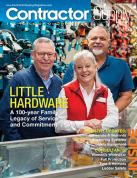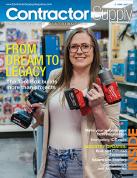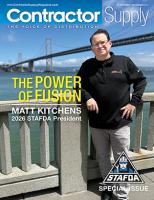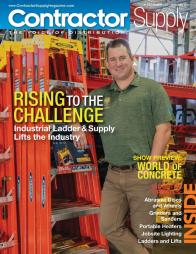Exclusive: Michelle St. John delivers 2018 STAFDA State of the Industry Distributor Perspective
2018 STAFDA president's State of the Industry Distributor address — in full.
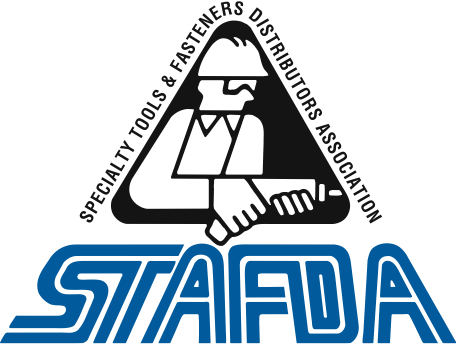 |
 |
Editor's Note: 2018 STAFDA president Michelle St. John delivered the State of the Industry Distributor Perspective during STAFDA's 2018 General Session held Monday, October 29, 2018 in Phoenix. Michelle is president and owner of Industrial Bolt & Supply, Auburn, Washington. The following is her address in full.
February, 1977 was the month that British rock band Manfred Mann topped the U.S. Billboard Hot 100 with their now-classic hit, "Blinded by the Light." It was the same month I turned 11 and my dad — armed with a yellow legal pad, a dream, unmatched ambition and a blue Chevy pickup truck – started our family business, Industrial Bolt & Supply.
We all remember our first job. For some it was a paper route; for others, babysitting or lawn mowing. For my brother and me, it was packing kegs of bulk products into smaller, resell-able units. It was a family affair that played out on the green shag carpet of our living room floor most Saturday nights over back to back episodes of The Love Boat and Fantasy Island. Imagine counting thousands of 16-14 blue butt connectors, by twos, into bags of 100.
I laugh when I consider the rote nature of this essential work that we now perform with scales and soon, total automation, and I smile when I remember how 5th-grade-me could not imagine we would ever sell all of those bags. I think of my mom, whose vacuum - instead of battling Barbie shoes and Legos - felt some remorse every time she sucked up a piece of “inventory” from our shag carpet jungle, and who once calculated the number of packages I counted to pay for my self-funded college education.
I am proud graduate of Washington State University’s school of business and economics and my 4 ½ year bachelors degree was funded by packaging — at 10 cents a bag — 160,000 bags of small consumable MRO parts. And not one, single, power tool. After hearing that, you may be wondering what qualifies me to address you.
To prepare for this opportunity to speak to you about the trends in our industry, I listened to Ted talks, studied articles on effective speech-writing and consulted friends and peers. You may know STAFDA Associate and liaison committee member Jude Nosek of Keson, Industries; but, what you may not know is Jude once worked as a speech writer, and during a recent visit to the Pacific Northwest, he coached me on the three keys to an effective speech.
First, he said, tell the audience what you’re going to tell them; second, tell them what you told them you were going to tell them and third; tell them what you just told them. So, I thought, perhaps I should begin by establishing some expectations… here are a few things you will not get from this message:
You won’t get a plug for my company or advice. Our business is a little different, so don’t expect any wise words on how we’re getting it right - instead, I hope you’ll think of this as a conversation with an unlikely peer who, like you, is figuring out how to remain profitably competitive at a time of extraordinary change.
You also won’t get humor. Although, the fact that I was trusted with this role as your association president even though I don’t have a single branch or even sell power tools, is kind of funny.
So, like I said, we don’t sell tools. We don’t have anything against tools; they are significantly more sexy than the nuts, bolts, drill bits, grinding wheels, cut off wheels, electrical terminals, brass fittings, epoxy systems, industrial chemicals and safety products we distribute … and we do occasionally give power tools away as incentives for purchasing our consumable maintenance supplies, but they just don’t fit our economic model.
We also don’t have branches. Our team of 28 sales people represent us in 9 western states and they work out of their homes … but they are not calling on job sites. Instead, they are working to reduce downtime and labor costs anywhere someone is turning a wrench in a maintenance application. We are the metal pigeon-hole-bin people. We create on-site inventory management environments in markets such as agriculture, mining, transportation, heavy equipment, municipalities, facilities like stadiums, hotels, schools and hospitals and even automotive aftermarket … and we ship it all from a single distribution center near Seattle. Basically … you all help build it and then we help maintain it.
Industrial Bolt & Supply was my first and will hopefully be my last job (I say that, because, when you grow up in a family business there’s a chance you’ve been fired once or twice along the way). This makes my brother and me second-generation owners. Some of you are wondering right now if this means that we either failed at our first careers or if we fooled our folks into trusting us not to kill the family business. There may be a little truth in both opinions, but the reality is, Derek and I are the grateful benefactors of a well-designed business whose story cannot be told without STAFDA.
My parents are Jack and Linda Butcher, and they have been loyal association members since attending STAFDA’s second convention in 1978. My dad, like any successful salesperson or entrepreneur, is competitive - always looking for an advantage - and aside from his extraordinary work ethic, STAFDA was his competitive edge.
| One of the ideas my dad took away from a STAFDA convention is so important to our company that it is a cornerstone philosophy of our business and the basis of the idea I want to explore with you today. The idea is that winning is defined by our ability to develop and sustain mutually profitable relationships with our customers, our suppliers and our personnel. |
I recall my parents returning from conventions… my mom toting plastic bags of trade show goodies for us to divvy up like candy on Halloween, and my dad with pages of notes from the hours of education that he received. He had a rule – I’m sure he learned from a one of the 67 books dedicated to the art of sales in his, now my, office – called the 72-hour rule.
Experts refer to it as “the law of diminishing potential.” This concept contends that as time passes following an education, the potential for change diminishes. Statistically, the rule suggests that if we have not taken the first step towards applying a new idea within the first 72 hours of learning it, the likelihood that the idea will be implemented into action and actually drive change is nearly zero. Well, my dad took this rule to heart and applied as many ideas from STAFDA’s expert faculty as he could as quickly as he could and the result was a profitable, sustainable business.
One of the ideas my dad took away from a STAFDA convention is so important to our company that it is a cornerstone philosophy of our business and the basis of the idea I want to explore with you today. The idea is that winning is defined by our ability to develop and sustain mutually profitable relationships with our customers, our suppliers and our personnel.
The headlines tell our story, times are good; and times are changing. Competing in today’s consumer-centric climate is different, but the challenge for us as an industry to remain competitive – year after year – anticipating and overcoming the obstacles that threaten our ability to win, is the same. I have always believed there is plenty of opportunity in our channel for companies of all sizes and niche distinctions to thrive, but there is no denying that maintaining, much less gaining a competitive advantage is more complex than ever.
The question is, how can STAFDA distributors profitably compete in an age of increasingly complex customer demands that are effectively changing the very way we conduct business?
Perhaps there are lessons from the past that we can build upon? This is not the first time the distribution industry has faced unprecedented competition and a rate of change that evokes metaphors of epic battles like David and Goliath, but many would agree that while the game - our quest to win customer loyalty - may remain the same, the rules and even the players are changing.
I read a staggering statistic that $.49 cents of every US e-commerce dollar spent is spent with Amazon. I hale from the land of Amazon which I wish made me an expert, but the truth is, like many of you, I am sizing up this giant while counting the stones in my arsenal, concerned that my weapons are insufficient for battle and that this is a contest I can’t win.
At the same time I am deliberating on how to compete with the very company who is defining our customers experience – one that demands expediency and economy – a combination that rarely equates to profitability - and, at a minimum, requires a healthy investment in technology to not only establish an online presence but to redefine the sales process in a way that both preserves the relationship and serves our mutual interests.
I worked for Procter & Gamble, during the emergence of Walmart in the early 90’s. If you remember that time, or perhaps live in a neighborhood where once stood a family owned grocery store that is now a gym, you may identify with this lesson. I recall the voice of my small independent grocers who feared they couldn’t survive the low-price-high-volume “attack” on mom and pop grocers.
This once-essential long-time channel for P&G became obsolete in what felt like overnight. “Walmart was just too big to ignore…” my boss explained to me, and it was true; P&G could not survive without partnering with them. We all recall how this warehouse model later materialized in our industry with the battle of the big box stores, and surely the advent of Amazon summons similar fears of the nearly predatory nature of these low-price outlets gobbling up small distributors.
Fears so real, I’ve heard peers say, “I just don’t know if we can win.”
| Can we profit by building off the model someone else has already invented, tested, and essentially trained our customers to expect? |
And then the optimist in me considers the words of baseball great Joe Torre who said, “competing at the highest level is not about winning…” and I wonder, what if winning is more about competing than defeating? I am as competitive as anyone and I like to win, but more than winning, I love a good game; a fierce matchup between tough competitors; the sort of battle that exposes the best in both opponents such that each is better because of the other.
So, let’s ask ourselves this… how can this competitor make us better? Can we profit by building off the model someone else has already invented, tested, and essentially trained our customers to expect?
If we can embrace one lesson from this now trillion-dollar channel player, it is the idea that we win when our customers win, or Mr. Bezos’s now famous mantra “it is all about the customer.”
I recently read a supply chain blog discussing the impact of e-commerce on wholesalers and distributors that cited three truths about the current state of procurement in our channel – customers are looking to buy online; big online players use technology to minimize customer interaction because it’s unprofitable, and industry experts still assert, “people, want to feel cared for.” This is good news! It means we are competing in the area of care, and isn’t this best accomplished through relationship? When was the last time a website anticipated your needs or made you feel cared for, the way a relationship with a trusted advocate did?
Your winning play book may look like a hybrid of online efficiencies that are not the answer in and of themselves, but rather, serve to amplify your de-digitized solutions and the indispensable value of your already expert customer service model - that unique element which has long been your competitive edge - to improve the customer experience. Your brand may be intangibles like responsiveness or customization, because rigidity is widely considered the Achilles heel of on-line giants.
If there are only two ways to gain a competitive advantage — do things better than your competition or do them differently — then differentiation will continue to be the name of the game. At a time when our star products are being nearly commoditized, however, how do we dispel sameness? Maybe it’s through private labeling? Perhaps your chop saw is bundled with your private branded blades – the ones with your name on them that only your company sells.
Maybe it’s a company app that literally positions you as a solution in the palm of your customers tech-savvy hand, or a loyalty program, or an obsolescence guarantee that acts as a form of relationship commerce; a program we employ to engage with our customers in a way that personalizes and quantifies our interest in their profitability.
Whatever your strategy to satisfy your customer’s demand for the convenience and economy of digital services, one message seems clear — the sooner we are able meet them where they are, the less likely they will be to migrate away.
We’ve all heard it said that the best defense is a good offense, and in our business, offense is synonymous with innovation. As a small distributor, besides our people, new products are our greatest asset. We depend on our manufacturers to innovate and educate - their role in our success cannot be under-stressed. We expect a lot from our suppliers, but we also believe we have a responsibility to perform for them.
I remember attending my first convention 25 years ago in San Francisco – I was pregnant with my first daughter, Madeleine, and my dad, who was serving on the board at that time, invited me to attend. Three things impressed me at that convention. 1. Meeting Morrie and Patsy Halvorsen and their daughter Georgia, who, with her mom, pretty much single-handedly ran registration. While easy to be impressed by these incredibly capable women, I was more impressed by their warmth and kindness.
The second thing that impressed me was the seemingly endless mounds of shrimp at the food stations within the Exploratorium during the Opening Party (if you were there, you remember the shrimp). I’d never seen anything like it before.
But what impressed me most was the trade show. No, not the show itself – although undeniably impressive – but the way manufacturers took time with my dad. We were so small, and we were looking for unique labor-saving products that we could put our name on. Anyone who is invested in this type of branding strategy understands that private labeling requires greater than typical minimums – a big risk for manufacturers and our company alike. My dad literally begged manufacturers to take a chance on us. And when they did, we were sure not to let them down. After all, they essentially hired us to take their product to market.
| Whether we have e-commerce capabilities or not, digital customer services is an offensive strategy that our customers and our suppliers expect. |
I fight to maintain this mentality when my profitability is compromised by things like acquisition, but I continue to feel a responsibility to shape our future company in a way that positions us as the best, most attractive and most profitable vehicle to take their innovation to market. I think one way all distributors can apply this philosophy is to embrace an on-line strategy that keeps pace with customer demands. Even if we don’t take the e-commerce plunge, can we economically enhance our digital service strategy in ways that make us more accessible, easier to search and easier to shop — while simultaneously supporting our suppliers’ efforts by backing their products with content?
Whether we have e-commerce capabilities or not, digital customer services is an offensive strategy that our customers and our suppliers expect. My company is not there yet, but we are utilizing one tool – a product called ZipWhip that allows our customers to text to our already existing toll-free landline. It is a small tool we use to gain a little additional accessibility to our customers while we endeavor to build out our comprehensive e-commerce solution.
When it comes to competing, I think the key for us is team. It may sound cliché, but we can’t really compete without each other. As an industry, particularly in this new “age of the customer,” we will continue to rely on each other to execute our respective positions in order to win our customers loyalty and profitably protect our share. But our dominance as a channel may be proportionate to the degree that distributors are able to collaborate with manufacturers who are equally dedicated to improving the customer experience, as well as being committed to investing resources to strengthen the distributors’ presence in the markets they serve.
If agility, technology, innovation, and collaboration are the position players of our winning offense, STAFDA is the trainer who assures we are fit to compete — equipping us with access to relevant, best in class information, education and resources.
As an industry, a single player cannot carry our team - any more than I believe a single competitor can defeat us. I imagine that the future of industrial distribution looks like high level channel collaboration fueled by customer engagement, empowered personnel, and the pursuit of mutually profitable relationships with our suppliers, our customers, and our people.
Competing in this new Age of the Customer will not be easy, but it may be just the challenge our team needs to not only test, but expose our collective strength. As Coach Torre said, “Competing at the highest level is not about winning … competing is about preparation, courage, understanding and nurturing your people, and heart. Winning is the result.” CS
Industrial Bolt & Supply was profiled in the October/November 2017 issue of Contractor Supply. Click here to read their story.
Learn more about STAFDA at www.STAFDA.org.







